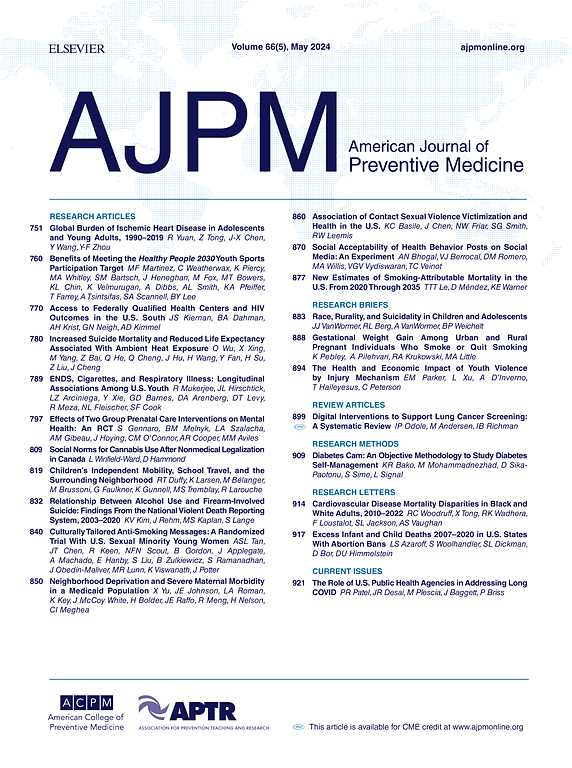分销合同类型对公共卫生领域竞争性品牌销售商采用区块链策略的影响
IF 4.5
2区 医学
Q1 MEDICINE, GENERAL & INTERNAL
引用次数: 0
摘要
本研究深入探讨区块链技术在双渠道供应链框架中的变革作用,强调其对提高公共卫生领域产品透明度的影响。通过确保与健康相关产品的可追溯性和真实性,区块链可以显著改变品牌制造商的定价动态。该研究探讨了透明度的提高如何使消费者做出更明智的选择,从而潜在地影响需求模式,从而影响品牌销售商采用的定价策略。最终,该研究旨在了解这些定价调整如何影响这些卖家在公共卫生部门的整体盈利能力和市场地位。方法以公共健康产品为研究对象,采用平台+上游品牌卖家的模型。分析了品牌销售商采用区块链技术在直销和平台销售两种渠道下的成本效益,以及公共卫生产品在批发和代理两种销售模式下的选择。结果研究发现,在公共卫生领域,采用区块链技术的成本对品牌销售商的决策有显著影响。在低成本条件下,品牌销售者倾向于采用区块链来提高公共卫生产品的透明度,这不仅可以吸引有健康意识的消费者,还可以增加市场份额,提升品牌形象。连锁成本水平也会影响品牌销售商在批发模式和代理模式之间的选择,以及公共卫生产品的定价策略。在批发模式下,较低的零售价格和较高的需求有助于增加公共卫生产品品牌卖家的利润。我们发现,在公共卫生领域,分销合同的类型对竞争性品牌卖家采用区块链策略有深远的影响。品牌销售者需要根据自身情况和市场环境选择合适的销售模式和区块链应用策略,增强公共卫生产品的透明度,吸引消费者,提高市场占有率,提升品牌形象。同时,各国政府和相关机构也应积极推动区块链技术在公共卫生领域的应用和发展,确保公众健康和安全。本文章由计算机程序翻译,如有差异,请以英文原文为准。
The Impact of Distribution Contract Types on the Adoption of Blockchain Strategies by Competitive Brand Sellers in the Field of Public Health
Introduction
This research delves into the transformative role of blockchain technology within a dual-channel supply chain framework, emphasizing its influence on enhancing product transparency in the public health domain. By ensuring the traceability and authenticity of health-related products, blockchain can significantly alter the pricing dynamics for brand manufacturers. The study explores how increased transparency can lead to more informed consumer choices, potentially affecting demand patterns and, consequently, the pricing strategies adopted by brand sellers. Ultimately, the research aims to understand how these pricing adjustments impact the overall profitability and market position of these sellers within the public health sector.
Method
This research uses a model consisting of a platform and upstream brand sellers, focusing on public health products. It analyzes the cost-effectiveness of brand sellers adopting blockchain technology in two channels: direct sales and platform sales, as well as the choice of public health products between two sales models: wholesale and agency.
Results
The study finds that in the field of public health, the cost of adopting blockchain technology has a significant impact on the decision-making of brand sellers. Under low-cost conditions, brand sellers tend to adopt blockchain to improve the transparency of public health products, which can not only attract health-conscious consumers but also increase market share and enhance brand image. The level of on-chain costs also affects the choice of brand sellers between wholesale and agency models, as well as the pricing strategy of public health products. Under the wholesale model, lower retail prices and higher demand help to increase the profits of brand sellers in public health products.
Discussion
We found that the type of distribution contract has a profound impact on the adoption of blockchain strategies by competitive brand sellers in the field of public health. Brand sellers need to choose appropriate sales models and blockchain application strategies based on their own situations and market environments to enhance the transparency of public health products, attract consumers, increase market share, and improve brand image. At the same time, governments and relevant institutions should also actively promote the application and development of blockchain technology in the field of public health to ensure public health and safety.
求助全文
通过发布文献求助,成功后即可免费获取论文全文。
去求助
来源期刊

American Journal of Preventive Medicine
医学-公共卫生、环境卫生与职业卫生
CiteScore
8.60
自引率
1.80%
发文量
395
审稿时长
32 days
期刊介绍:
The American Journal of Preventive Medicine is the official journal of the American College of Preventive Medicine and the Association for Prevention Teaching and Research. It publishes articles in the areas of prevention research, teaching, practice and policy. Original research is published on interventions aimed at the prevention of chronic and acute disease and the promotion of individual and community health.
Of particular emphasis are papers that address the primary and secondary prevention of important clinical, behavioral and public health issues such as injury and violence, infectious disease, women''s health, smoking, sedentary behaviors and physical activity, nutrition, diabetes, obesity, and substance use disorders. Papers also address educational initiatives aimed at improving the ability of health professionals to provide effective clinical prevention and public health services. Papers on health services research pertinent to prevention and public health are also published. The journal also publishes official policy statements from the two co-sponsoring organizations, review articles, media reviews, and editorials. Finally, the journal periodically publishes supplements and special theme issues devoted to areas of current interest to the prevention community.
 求助内容:
求助内容: 应助结果提醒方式:
应助结果提醒方式:


